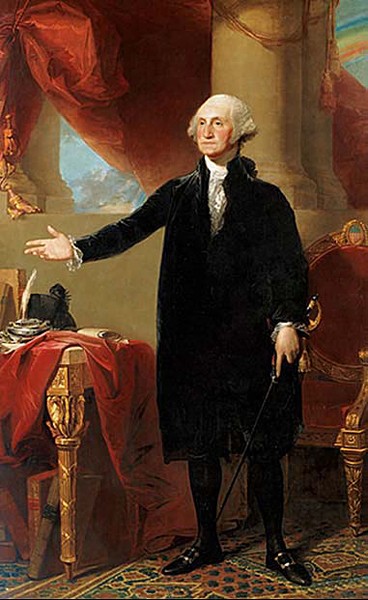2018 School Spending Survey Report
Portrait Lost for Generations Could Be in a School
A large, famous painting of George Washington with a mysterious history may have wound up hanging in a school.
 Some 200 years later, the painting still hangs in the White House. But whether that work, on display in the East Room, is authentic is debated— especially by one art historian who believes it may be lodged, unnoticed, in a school or library.
Some 200 years later, the painting still hangs in the White House. But whether that work, on display in the East Room, is authentic is debated— especially by one art historian who believes it may be lodged, unnoticed, in a school or library. A legend cloaked in mystery
According to the memoir of President Madison’s personal slave, the story of Mrs. Madison making off with the treasure is a myth. “She had no time for doing it. It would have required a ladder to get it down," the memoir reads. "All she carried off was the silver in her [handbag], as the British were thought to be but a few squares off, and were expected any moment.” The painting was snatched from the flames, but not by Dolley. It turns out that the President’s gardener and his door-keeper bundled the painting, along with urns and a few other easy-to-grab valuables, onto a wagon to safety. But another question remains: Did Madison's servants struggle so hard to save a fake? That’s the position that Dorinda Evans takes. Evans has been an art historian for nearly 50 years, and though she retired from the staff of Emory University, she remains dedicated to the painting and its creator. “I've written two books on Stuart and have long been convinced that the White House portrait is not by him,” she said. “It’s a forgery of a missing painting.” The real one, she speculates, could be in a large school or library today.A trail clouded by deception
Through her research, Evans has discovered that an English artist named William Winstanley had received the original from a business partner in Northumberland, a Mr. Laing. The arrangement was such that Winstanley could copy Stuart’s work and sell the imitations, a common way for artists to make money at the time. Then Laing sold the original to the United States Government in the spring of 1800. After making the deal, he told Winstanley to ship Stuart’s painting to Washington, DC to be hung in the White House. Evans says this is when Winstanley sent off a copy and kept the original. Later that year, Winstanley sold Stuart’s authentic work at an auction in New York, according to records, says Evans. There’s evidence in Evan’s research that deception was not out of character for Winstanley. He was thrown into debtor's prison when he returned to England after the auction in New York. He escaped by dressing up as a washerwoman, but was later caught and brought back to jail.Could it be hanging in a school?
Where the original wound up after the auction, let alone its current location, is still unknown. But standing at an estimated 96 inches high, it’s not likely to have been misplaced, or tucked into a closet somewhere. So where could a painting that large be hiding? “Because of its great size, it would be most suitable for a mansion or a school staircase,” Evans hypothesizes. Trying to generate a lead in her search, Evans contacted Ric Hasenyager, director of library services for the New York City Department of Education. Given the trail goes cold after that long-ago auction in New York City, she's focusing her search on schools and libraries in that area. “To my knowledge there’s no such artwork in our schools,” said Hasenyager. When he mentioned Evans’s quest to a colleague in the arts department, the coworker doubted that the painting would be in a school undiscovered, noting that the insurance cost for a painting from a high-profile artist would be something that the school would be very aware of. Still, Hasenyager admits, “It’s not too far fetched that a piece of art would be donated. [The NY DOE] has a Lichtenstein, so there are significant pieces.”Other experts disagree
The switcheroo theory is just that—a theory. Peggy O’Connor, the executive director at the Gilbert Stuart Museum in Saunderstown, RI, says that she believes the painting on display in the White House was created by Stuart. Still, she praised Evans’s skill and determination in her determination to solve the quandary. “Dorinda’s like a terrier—when she gets an idea in her head she goes with it. She’s tenacious and an excellent researcher,” O’Connor said. “I hope she does find new information.” Although the White House staff has acknowledged that they believe that the painting is genuine, Evans notes that when the artist himself saw the painting that hung in the White House, he denied painting it. It is largely agreed that even if the White House painting is authentic, it is not Stuart’s best work. So nobody can say definitively whether his denial was true, or based in embarrassment. In addition to spreading the word about her search—in the hopes of getting new information—Evans says her next step is traveling to England to find out more about Winstanley. For now, the mystery continues.RELATED
RECOMMENDED
CAREERS
The job outlook in 2030: Librarians will be in demand
CAREERS
The job outlook in 2030: Librarians will be in demand
ALREADY A SUBSCRIBER? LOG IN
We are currently offering this content for free. Sign up now to activate your personal profile, where you can save articles for future viewing






Add Comment :-
Be the first reader to comment.
Comment Policy:
Comment should not be empty !!!